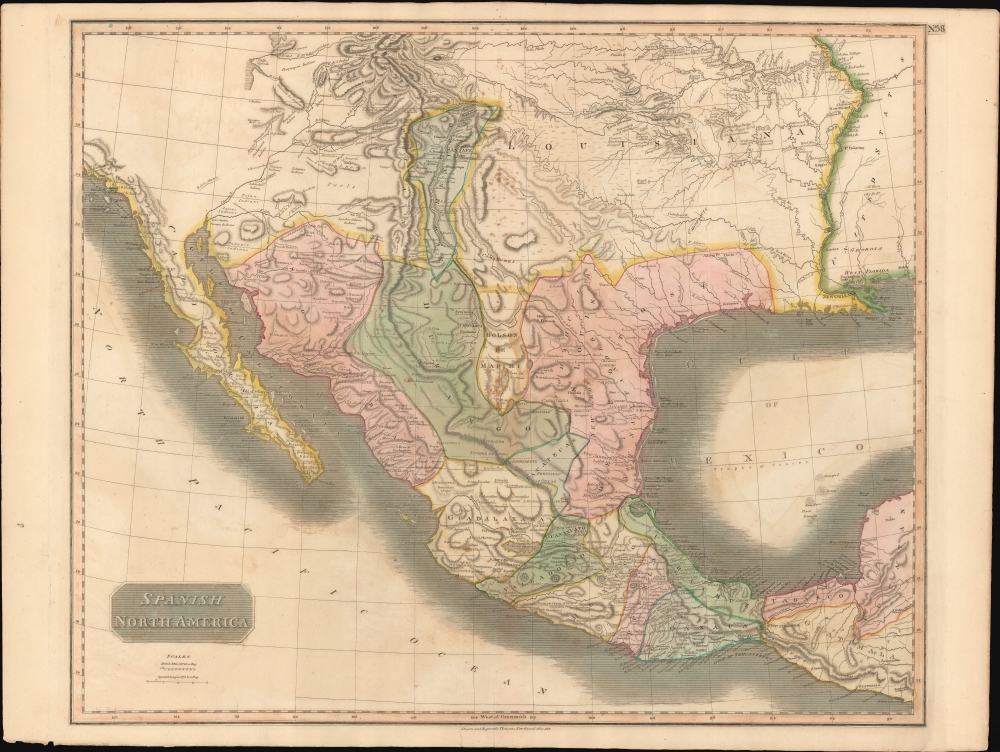1814 Thomson Map of Mexico and Texas
SpanishNorthAmerica-thomson-1814-2
Title
1814 (dated) 20 x 24.5 in (50.8 x 62.23 cm) 1 : 6200000
Description
A Closer Look
The map depicts Mexico from the Yucatan north to what would soon become the Republic of Texas, the Louisiana Territory, and what would eventually be the U.S. States of New Mexico, Arizona, Texas, California, Nevada, Utah, Louisiana, Oklahoma and Colorado. Based largely on the maps of Alexander von Humboldt and Zebulon Pike, the general treatment of the Rocky Mountains is drawn directly from Humboldt's important map of 1811, issued just 3 years prior. The 1806 - 1807 explorations of Zebulon Pike in modern-day Colorado are also in evidence, as is Pike's Peak, here noted as the 'Highest Peak.' The name Texas appears on this map only as the name of a settlement on the Colorado River, which is here mapped twice. The Great Salt Lake is mapped according to the limited knowledge preserved from the Escalante-Onate expedition of 1776. Here both the Great Salt Lake and Utah Lake are mapped, both with indistinct borders. The Louisiana region is especially well notated with numerous annotations regarding American Indian tribes and several advances over Humboldt - including the correct mapping of the Arkansas River.Publication History and Census
This map was 'Drawn and Engraved for Thomsons New General Atlas 1814.' It was likely engraved by John and George Menzies, like the other maps in the atlas, but is unattributed. This is the first edition of Thomson's map from the 1814 edition of the Atlas. Subsequent editions were published in 1817 and 1826. This map is an essential addition to any serious Texas, Transmississippi, or Southwest collection.CartographerS
John Thomson (1777 - c. 1841) was a Scottish cartographer, publisher, and bookbinder active in Edinburgh during the early part of the 19th century. Thomson apprenticed under Edinburgh bookbinder Robert Alison. After his apprenticeship, he briefly went into business with Abraham Thomson. Later, the two parted ways, John Thomson segueing into maps and Abraham Thomson taking over the bookbinding portion of the business. Thomson is generally one of the leading publishers in the Edinburgh school of cartography, which flourished from roughly 1800 to 1830. Thomson and his contemporaries (Pinkerton and Cary) redefined European cartography by abandoning typical 18th-century decorative elements such as elaborate title cartouches and fantastic beasts in favor of detail and accuracy. Thomson's principle works include Thomson's New General Atlas, published from 1814 to 1821, the New Classical and Historical Atlas of 1829, and his 1830 Atlas of Scotland. The Atlas of Scotland, a work of groundbreaking detail and dedication, would eventually bankrupt the Thomson firm in 1830, at which time their plates were sequestered by the court. The firm partially recovered in the subsequent year, allowing Thomson to reclaim his printing plates in 1831, but filed again for bankruptcy in 1835, at which time most of his printing plates were sold to A. K. Johnston and Company. There is some suggestion that he continued to work as a bookbinder until 1841. Today, Thomson maps are becoming increasingly rare as they are highly admired for their impressive size, vivid hand coloration, and superb detail. More by this mapmaker...
John Menzies (October 27, 1772 - October 16, 1857) was a Scottish engraver active in Edinburgh during the late 18th and early 19th centuries. Menzies mastered engraving as an apprentice to James Rymer. In 1811, he partnered with his younger brother, George Menzies, to found the engraving firm of J. and G. Menzies, which was active until about 1831. Later his son, also named John, joined the firm and they engraved jointly under the imprint of J. Menzies and Son. At its height, the Menzies firm employed three men and three apprentices. Menzies engraved maps for Thomas Brown and John Thomson, among others. After his death, his son, John Menzies II (1819 – 1891), continued the family business until about 1891. Learn More...

